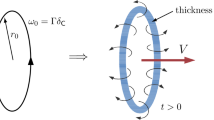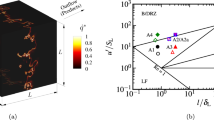Abstract
It is well-known in the combustion community that curvature effect in general slows down flame propagation speeds because it smooths out wrinkled flames. However, such a folklore has never been justified rigorously. In this paper, as the first theoretical result in this direction, we prove that the turbulent flame speed (an effective burning velocity) is decreasing with respect to the curvature diffusivity (Markstein number) for shear flows in the well-known G-equation model. Our proof involves several novel and rather sophisticated inequalities arising from the nonlinear structure of the equation. On a related fundamental issue, we solve the selection problem of weak solutions or find the “physical fluctuations” when the Markstein number goes to zero and solutions approach those of the inviscid G-equation model. The limiting solution is given by a closed form analytical formula.
Similar content being viewed by others
References
Anantharaman N.: On the zero-temperature or vanishing viscosity limit for certain Markov processes arising from Lagrangian dynamics. J. Eur. Math. Soc. (JEMS) 6(2), 207–276 (2004)
Anantharaman N., Iturriaga R., Padilla P., Sánchez-Morgado H.: Physical solutions of the Hamilton– Jacobi equation. Discret. Contin. Dyn. Syst. Ser. B 5(3), 513–528 (2005)
Caffarelli L.A., Monneau R.: Counter-example in three dimension and homogenization of geometric motions in two dimension. Arch. Ration. Mech. Anal. 211(2), 503–574 (2014)
Cardaliaguet P., Nolen J., Souganidis P.: Homogenization and enhancement for the G-equation in periodic media. Arch. Ration. Mech. Anal. 199(2), 527–561 (2011)
Chaudhuri S., Wu F., Law C.K.: Scaling of turbulent flame speed for expanding flames with Markstein diffusion considerations. Phys. Rev. E 88, 033005 (2013)
Evans L.C.: Towards a Quantum Analog of Weak KAM Theory. Commun. Math Phys. 244(2), 311–334 (2004)
Jauslin H., Kreiss H., Moser J.: On the forced Burgers equationwith periodic boundary conditions. Proc. Symp. Pure Math. 65, 133–153 (1999)
Lions, P.L., Papanicolaou, G.C., Varadhan, S.R.S.: Homogenization of Hamilton–Jacobi equation. unpublished preprint, circa 1986
Lions P.L., Souganidis P.E.: Homogenization of degenerate second-order PDE in periodic and almost periodic environments and applications. Ann. Inst. H. Poincaré Anal. Non Linaire 22(5), 667–677 (2005)
Liu Y., Xin J., Yu Y.: Asymptotics for turbulent flame speeds of the viscous G-equation enhanced by cellular and shear flows. Arch. Ration. Mech. Anal. 199(2), 527–561 (2011)
Luo S., Tran H., Yu Y.: Some inverse problems in periodic homogenization of Hamilton––Jacobi equations. Arch. Ration. Mech. Anal. 221(3), 1585–1617 (2016)
Markstein G.H.: Experimental and theoretical studies of flame front stability. J. Aero. Sci. 18, 199–209 (1951)
Matalon M., Matkowsky B.J.: Flames as gasdynamic discontinuities. J. FluidMech. 124, 239–259 (1982)
Osher S., Fedkiw R.: Level Set Methods and Dynamic Implicit Surfaces. Springer, New York (2002)
Pelce P., Clavin P.: Influence of hydrodynamics and diffusion upon the stability limits of laminar premixed flames. J. Fluid Mech. 124, 219–237 (1982)
Peters N.: Turbulent Combustion. Cambridge University Press, Cambridge (2000)
Ronney P.: Some open issues in premixed turbulent combustion. In: Buckmaster, J.D., Takeno, T. (eds) Modeling in Combustion Science. Lecture Notes In Physics, vol. 449, pp. 3–22. Springer, Berlin (1995)
Sethian, J.: Curvature and the evolution of fronts. Commun. Math. Phys. 101(4), 487–499 (1985)
Xin J., Yu Y.: Periodic Homogenization of Inviscid G-equation for Incompressible Flows. Commun. Math Sci. 8(4), 1067–1078 (2010)
Author information
Authors and Affiliations
Corresponding author
Additional information
Communicated by L. Caffarelli
The work was partly supported by NSF Grants DMS-1211179 (JX), DMS-0901460 (YY), and CAREER Award DMS-1151919 (YY).
Rights and permissions
About this article
Cite this article
Lyu, J., Xin, J. & Yu, Y. Curvature Effect in Shear Flow: Slowdown of Turbulent Flame Speeds with Markstein Number. Commun. Math. Phys. 359, 515–533 (2018). https://doi.org/10.1007/s00220-017-3060-1
Received:
Accepted:
Published:
Issue Date:
DOI: https://doi.org/10.1007/s00220-017-3060-1




